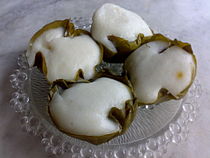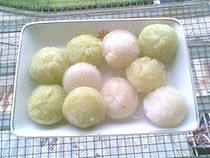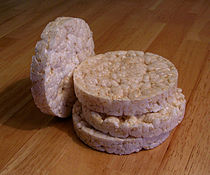- Rice cake
-
 Cantonese sweet nian gao cake, pan-fried
Cantonese sweet nian gao cake, pan-fried
 Tteok, Korean rice cakes
Tteok, Korean rice cakes Idli, a south Indian savory cake
Idli, a south Indian savory cake
 Puto, a Filipino steamed rice cake
Puto, a Filipino steamed rice cake
 Mochi, a Japanese cake made from glutinous rice
Mochi, a Japanese cake made from glutinous rice
 Steamed Bánh bò, a sweet, chewy Vietnamese sponge cake made from rice flour
Steamed Bánh bò, a sweet, chewy Vietnamese sponge cake made from rice flour
 Lontong, popular in Indonesia and Malaysia, made of compressed rice rolled into a banana leaf
Lontong, popular in Indonesia and Malaysia, made of compressed rice rolled into a banana leaf
A rice cake may be any kind of food item made from rice that has been shaped, condensed, or otherwise combined into a single object. A wide variety of rice cakes exist in many different cultures in which rice is eaten, and are particularly prevalent in Asia. The origin of rice cake seems to be Korea, in which the people of the ancient empires made Tteok since the bronze age. Common variations include cakes make with rice flour, those made from ground rice, and those made from whole grains of rice compressed together or combined with some other binding substance.
Contents
Types of rice cakes by region
Types of rice cake include:
In Chinese cuisine
- Nian gao includes many varieties, all made from glutinous rice that is pounded or ground into a paste and, depending on the variety, may simply be molded into shape or cooked again to settle the ingredient.
- Tangyuan is made by mixing glutinous rice flour with a small amount of water to form balls and is then cooked and served in boiling water.
- Erkuai literally means "ear piece," a reference to the shape of one of its common forms.
- Tainan Bowl Rice Cake has its origins in the southern Taiwanese city, Tainan. The dish is made by steaming glutinous rice once, then putting toppings in it and steaming it again.
In Indian cuisine
- Pitha, in the Cuisine of Assam and Oriya cuisine, is a thin-flat cake prepared from a batter usually made with soaked and ground rice, and cooked on a hot griddle or frying pan. Once made, the cakes could be fried in oil, roasted over a slow fire or baked and rolled over a hot plate. It is generally made only on special occasions like Bihu in Assam and many east Indian Festivals.
- Idli in South Indian cuisine. The cakes are usually two to three inches in diameter and are made by steaming a batter consisting of fermented black lentils (de-husked) and rice.
- Puttu in South Indian cuisine, consists of firm cylinders of steamed ground rice with layers of coconut.
In Filipino cuisine
- Puto is a steamed rice cake prepared practically all over the country and eaten alone, with butter or butter substitute and/or grated fresh coconut or as accompaniment to a number of savory dishes for breakfast, as morning or afternoon snack and as finger food for gatherings and festivities. Properly prepared puto is fluffy, light, soft, chewy, moist, has fine uniform grains and imparts a slightly yeasty aroma of fermented rice batter overlaid with a light whiff of anise seeds.
- Kalamay is made of glutinous rice, grated coconut, brown sugar, margarine, peanut butter, and, optionally, vanilla.
- Suman is made from glutinous rice cooked in coconut milk, and often steamed in banana leaves.
- Bibingka is a type of rice cake made with rice flour and coconut milk or water and lined with banana leaves. It is traditionally baked using specially made clay ovens and preheated charcoal.
- Espasol is made from rice flour cooked in coconut milk and sweetened coconut strips, dusted with toasted rice flour.
- Sapin-sapin is a layered glutinous rice and coconut dessert in Filipino cuisine made from rice flour, coconut milk, sugar, water, and coloring with coconut flakes sprinkled on top.
- A common snack or merienda in Filipino culture, Filipinos have created many different kinds of rice cakes. In local language, it is called kakanin, derived from the word kanin, meaning (prepared) rice. Aside from those mentioned above, examples include kutsinta, biko, palitaw, sinabalo, enkiwar, puto bumbong, binalay, tupig and suman.
In Japanese cuisine
- Mochi is made of glutinous rice pounded into paste and molded into shape. In Japan it is traditionally made in a ceremony called mochitsuki. While also eaten year-round, mochi is a traditional food for the Japanese New Year and is commonly sold and eaten during that time. Mochi is also a prominent snack in Hawaii, Taiwan, Cambodia, and Thailand.
- Senbei are a type of Japanese rice crackers, usually cooked by being baked or grilled, traditionally over charcoal. While being prepared they may be brushed with a flavoring sauce, often one made of soy sauce and mirin. They may then be wrapped with a layer of nori. Alternatively they may be flavored with salt or so-called "salad" flavoring.
In Vietnamese cuisine
- Bánh bèo is a variety of small steamed rice cake or rice pancake typically featuring a dimple in the center, which is filled with savory ingredients including chopped dried or fresh shrimp, scallions, mung bean paste, crispy fried shallots, fish sauce, rice vinegar, and oil.
- Bánh bò is a sweet, chewy sponge cake made from rice flour, water, sugar, and yeast.
- Bánh đúc is a cake made from non-glutinous rice flour (although corn flour is also used in northern Vietnam). In the north it is typically garnished with savory ingredients such as ground pork, tôm chấy (grilled ground shrimp), fried onions, sesame seeds, salt, peanuts, lime juice, and soy sauce or fish sauce. In the south, it is served as a dessert, and takes the form of gelatinous blocks that are often colored green by the addition of Pandanus amaryllifolius leaf extract. It is cooked by boiling the ingredients and allowing them to cool, solidifying into a jelly-like sheetphoto that is then cut into blocks.
- Bánh chưng is made from glutinous rice, mung bean, pork and other ingredients. Bánh tét is much the same but cut in a circular form, and consumed in celebration of the Vietnamese holiday Tết.
In Korean cuisine
- Tteok, a class of Korean cakes made with glutinous rice flour (also known as sweet rice or chapssal). Normal rice flour can be used for some kinds of tteok. There are hundreds of different kinds of tteok eaten year round. In Korea, it is customary to eat tteok guk (tteok soup) on New Year's Day and sweet tteok at weddings and on birthdays. It is often considered a celebratory food and can range from rather elaborate versions or down to the plain-flavored tteok. Tteok is usually divided into four categories: "Steamed tteok" (찌는 떡, 甑餠), "Pounded tteok" (치는 떡, 搗餠), "Boiled tteok" (삶는 떡 搗餠) and "Pan-fried tteok" (지지는 떡 油煎餠).
- Sirutteok is one kind of steamed tteok that are rice (맵쌀, maepssal in Korean) or glutinous rice (찹쌀 chapssal) and sometimes they are mixed together with (but not limited to) other grains, beans (azuki beans or mung beans), sesame seeds, wheat flour, or starch can be mixed with the rice. Fruits and nuts are used as subsidiary ingredients.
- Injeolmi is an example of pounded tteok. The traditional preparation for pounded tteok is made by pounding rice or glutinous rice with utensils called jeolgu and jeolgutgongi or tteokme and anban. Injeolmi (tteok coated with bean powder), garaetteok (가래떡 cylinder-shaped white tteok), jeolpyeon (절편 patterned tteok) and danja (단자 glutinous tteok ball coated with bean paste)” are commonly eaten pounded tteok.
- Songpyeon and Bupyeon are rice cakes which have been molded into shaped. There are dozens of these kinds of cakes in Korea, some can consist of doughs of glutinous rice flour and a sweet filling and covered with gomul, kind of powdered beans.[1] Ggul tteok (꿀떡) - literally means "tteok with honey" but the tteok is stuffed with Korean syrup. Ggul tteok is similar to songpyeon in shape, but smaller in size.
- Hwajeon[2] - small sweet pancakes made of flour of glutinous rice, and flower petals of Korean azalea, chrysanthemum, or rose.
- Tteokbokki is another dish apart from tteok guk that is made with tteok. It is a (usually) spicy dish commonly sold by street vendors, made with garaetteok.
In other cuisines
- Ketupat, or packed rice is a type of dumpling from Brunei, Indonesia, Malaysia, the Philippines (where it is known by the name pusô in Cebuano, bugnóy in Hiligaynon, patupat in Kapampangan, or ta'mu in Tausug), and Singapore. It is made from rice that has been wrapped in a woven palm leaf pouch and boiled. As the rice cooks, the grains expand to fill the pouch and the rice becomes compressed. This method of cooking gives the ketupat its characteristic form and texture of a rice dumpling. Ketupat is usually eaten with rendang or served as an accompaniment to satay or gado-gado. Ketupat is also traditionally served by Malays at open houses on festive occasions such as Idul Fitri (Hari Raya Aidilfitri). During Idul Fitri in Indonesia, ketupat is often served with opor ayam (chicken in coconut milk}, accompanied with spicy soy powder.
- Chwee kueh, (literally "water rice cake") is a type of steamed rice cake, a cuisine of Singapore and Johor. It is made by mixing rice flour and water to form a slightly viscous mixture, which is then placed in small cup-shaped containers that look like saucers and steamed, forming a characteristic bowl-like shape when cooked. The rice cakes are topped with diced preserved radish and served with chilli sauce. Chwee kueh is a popular breakfast item in Singapore and Johor.
- Lontong, popular in Indonesia and Malaysia, is made of compressed rice that is then cut into small cakes. It is traditionally made by boiling the rice until it is partially cooked and packing it tightly into a rolled-up banana leaf. The leaf is secured and cooked in boiling water for about 90 minutes. Once the compacted rice has cooled, it can be cut up into bite-sized pieces. The dish is usually served cold or at room temperature with sauce-based dishes such as gado-gado and salads, although it can be eaten as an accompaniment to other dishes such as Satay and curries.
- Puffed rice cakes, popular in North America and other Western countries, are made with puffed rice, a puffed grain usually created by heating rice kernels under high pressure in the presence of steam, though the method of manufacture varies widely. The puffed grains are then bonded together by a wide variety of methods in the form of a cake. They are popular for young children, and when eaten by them they are often apple or honey flavoured.
- Rijsttaart and Rijstevlaai in Dutch and Belgian cuisine are kinds of rice pie, with the filling of mixed rice, sugar, eggs and milk.
References
Categories:- Rice dishes
Wikimedia Foundation. 2010.


